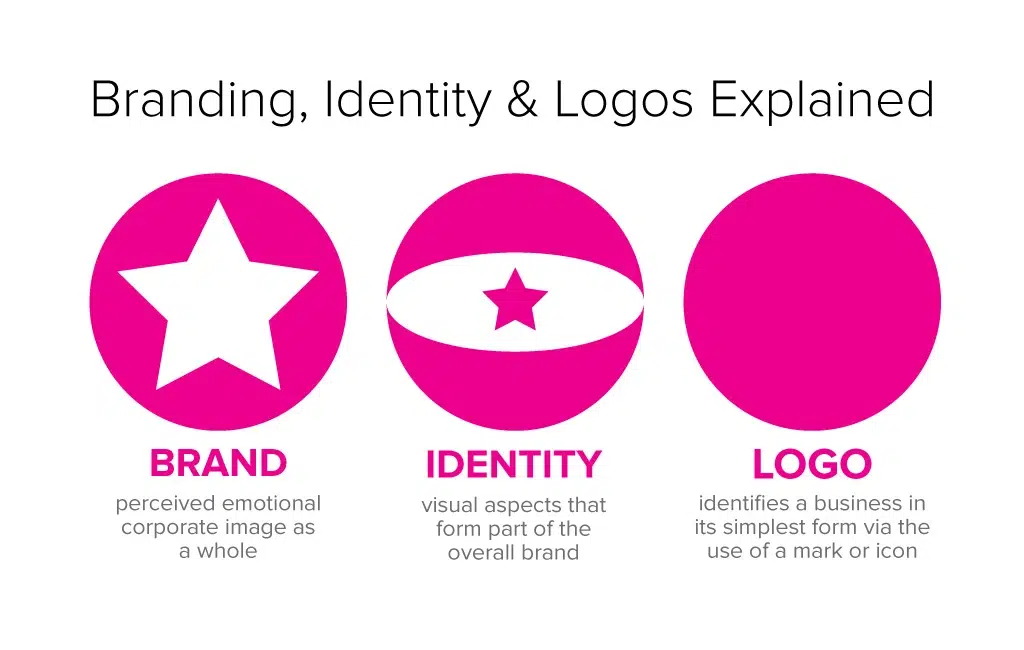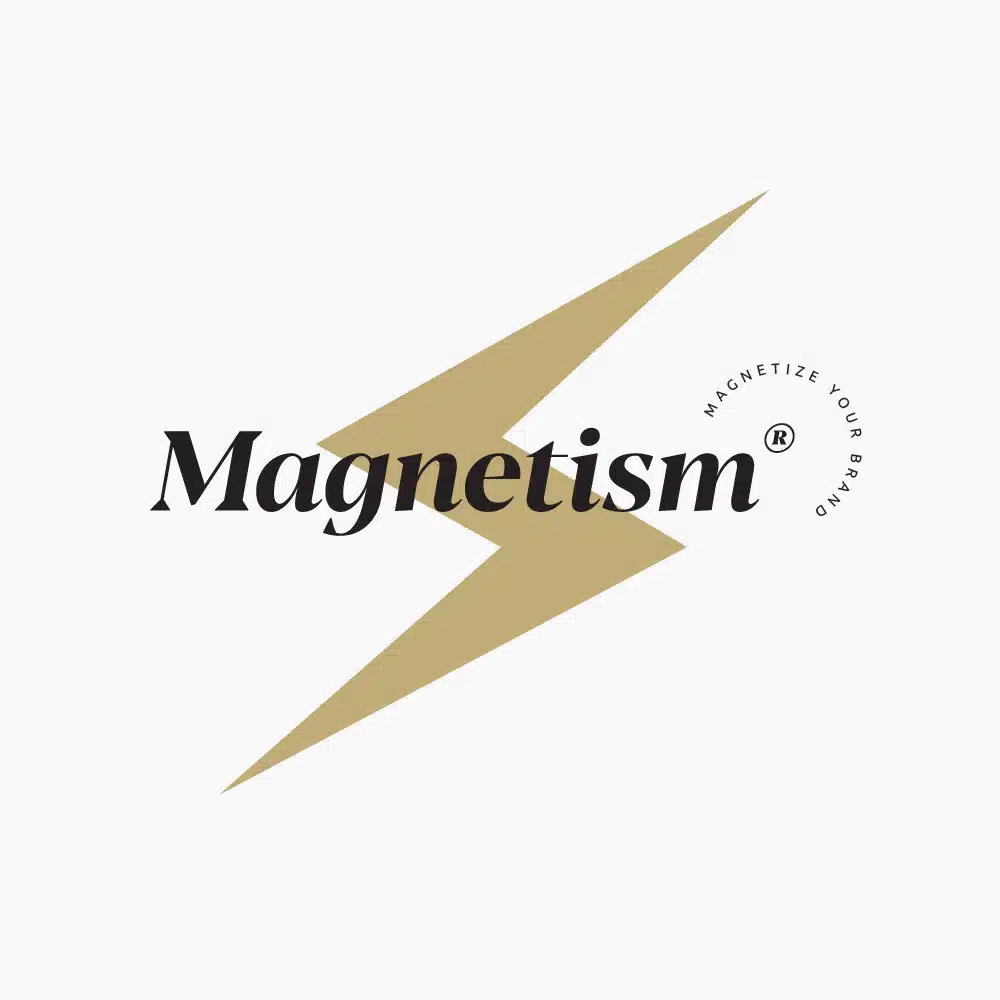Have you ever wondered why some brands are instantly recognizable and memorable while others fade into the background? The key lies in effective branding, identity, and logo design. If you’re curious about what these terms mean and how they contribute to a successful brand, you’re in the right place.
In the world of competitive markets, it is important to establish a strong brand identity to gain a competitive edge and effectively engage with your target customers. Understanding branding decisions can be challenging, especially for those new to marketing and design.

This article will provide valuable insights and guidance on the concepts of branding, identity, and logo design and how they work together to create a cohesive brand image and make a business memorable. Whether you’re a business owner, a marketer, or someone interested in branding, this article clarifies these concepts.
Branding, Identity & Logo Design
A logo does not represent your brand or define your brand identity. Logo design, identity design, and branding play distinct roles in shaping the perceived image of a business or product.
There has been some recent discussion on the web about this topic, about your logo not being your brand. Although this may be true, I haven’t seen any clarification of the difference between branding, logo, and a company’s brand identity. I wish to rectify this.
What is a brand? – The perceived emotional corporate image as a whole.
What is identity? – The visual aspects that form part of the overall brand.
What is a logo? – A logo identifies a business in its simplest form via a mark or icon.
To explain this in more detail, let’s start at the top – the brand.
What is Branding?

Branding is certainly not a light topic – whole publications & hundreds of books have been written on the subject; however, to put it in a nutshell, you could describe a ‘brand’ as an organization, service, or product with a ‘personality’ that is shaped by the perceptions of the audience. On that note, it should also be stated that a designer cannot “make” a brand – only the audience can do this. A graphic designer forms the foundation of the company’s brand image.
Many people believe a brand’s identity only consists of a few branding elements – a color scheme, fonts, a logo, a slogan, and maybe some music added. In reality, it is much more complicated than that. You might say that a brand is a ‘corporate image.’
The fundamental idea and core concept behind having a ‘corporate image’ is that everything a company does, everything it owns, and produces should reflect the core values and aims of the business as a whole.
The consistency of this core idea makes up the company, driving it, showing what it stands for, what it believes in, and why it exists. It is not purely some colors, typefaces, a logo, and a slogan.
For example, let’s look at the well-known IT company Apple. Apple, as a company, projects a humanistic corporate culture and a solid corporate ethic, one which is characterized by volunteerism, support of good causes & involvement in the community.
These values of the business are evident throughout everything they do, from their innovative products and advertising to their customer service.
Apple is an emotionally humanist brand with a strong connection with customers – when people buy or use their products or services, they feel part of the brand, like a tribe. This emotional connection creates their brand – not purely their products and a bite-sized logo.
For a more thorough understanding of successful branding, in simple terms, I recommend Wally Olin’s: The Brand Handbook, which I quote is “an essential, easy-reference guide to brilliant branding”.
What is Identity Design?

One major role in a company’s ‘brand’ or ‘corporate image’ is its visual identity.
In most cases, visual identity design is based on the visual devices used within a company, usually assembled within a set of branding guidelines. These guidelines that make up an identity usually administer how the identity is applied throughout various mediums, using approved color palettes, fonts, layouts, measurements, etc.
These guidelines ensure that the identity of the company is kept coherent, which, in turn, allows the brand, as a whole, to be recognizable to potential customers.
The visual identity or ‘image’ of a company is made up of many visual elements:
- A Logo (The symbol of the entire identity & brand)
- Stationery (Letterhead + business card + envelopes, etc.)
- Marketing Materials (Flyers, brochures, books, websites, etc.)
- Products & Product Packaging Design (Products sold and the packaging in which they come in)
- Apparel Design (Tangible elements like clothing items that employees wear)
- Signage (Interior & exterior design)
- Messages & Actions (Messages conveyed via indirect or direct modes of communication like social media posts)
- Other Communication (Audio, smell, touch, etc.)
- Any visual design assets representing the business.
All of these things make up a strong identity and should support the brand as a whole. The logo, however, is the overall corporate identity and brand all wrapped up into one identifiable mark. This mark is the avatar and symbol of the business as a whole.
What is a Logo?

To understand what a logo is, we must first understand what it is for.
A logo is for… identification.
A logo identifies a company or product using a mark, flag, symbol, or signature. A logo does not sell the company directly, nor rarely does it describe a business. Logos derive their meaning from the quality of the thing it symbolizes, not vice versa – logos are there to identify, not to explain. In a nutshell, what a logo means is more important than what it looks like.
To illustrate this concept, think of logos like people. We prefer to be called by our names – James, Dorothy, John – rather than by the confusing and forgettable description of ourselves, such as “the guy who always wears pink and has blonde hair.” Similarly, a well-designed logo should not literally describe what the business does but identify the company recognizably and memorably.
It is also important to note that only after a company logo becomes familiar does it function as intended, much like how we must learn people’s names to identify them.
An effective logo identifies a business or product in its simplest form.
Summary:
A strong brand identity is established through effective branding, identity establishment, and logo design, all of which are pivotal in crafting a memorable and easily identifiable brand.
The branding process involves shaping how a business or product is perceived by its audience, while visual identity design plays a significant role in building a loyal customer base by utilizing distinct visual elements associated with the brand.
Brand –The perceived emotional corporate image as a whole.
Identity – The visual aspects that form part of the overall brand.
Logo – Identifies a business in its simplest form using a mark or icon.
How would you summarise brand, identity, and logo design? Comments and thoughts are welcome, as always.
Logo Design Resources:
- What makes a good logo?
- How to design a logo – 5 vital tips
- Ultimate list of logo design resources
- How to choose a logo designer
Photos by Taylorkoa22, Ronaldo F Cabuhat, Bloomberg News











Thanks for the distinction.
I love the analogy of a person having a nickname and a business having a logo. It’s a good way to explain to someone who thinks their logo should be a literal icon of what they do.
Thanks!
This is a big and complicated issue, but let me try and boil it down.
The Brand is the human attributes of a non-human entity.
The Identity is the sensory elements which help you make a human/emotional connection.
The Logo is a symbol which represents the identity, and in turn, the brand.
I also liked the people’s names analogy. Logos are my best friends. LOL
😉
Thanks for the distinction , because i need it more about creating logo design which is exploring our business more So i am also interesting for it
Great way of explaining the differences between the three. It is very easy to get them confused. This will be very helpful when explaining to others.
Thanks for the insightful definitions of these terms Jacob. Many people misunderstand them. Some expect the designer to build their brands. Do you think that designers should educate their clients about this before we even start the project?
I disagree a little bit with the “logo not having to describe what a company does”. Sometimes it is better if it does. To me, it depends of the type o company and if there’s going to be any marketing applied. What I mean is, if I’m doing the logo for Pepsi, let’s say, the logo doesn’t need to say what Pepsi is, so something recognizable and memorable would be enough because there’s going to be a lot of advertising involved to let people know that Pepsi is a soda. But if I do the logo for John the plumber then having something in the logo that says what he does to me is a must because John won’t have the same amount of advertising than Pepsi… so there you go, hope I made my point clear 🙂
Cheers!
Leo
quite an interesting and better explained. Leo.. i agree with you absolutely
Another stunning post. Quite good comments going as well.
I’m visiting JCD to learn new things. And always, i am not the same person who leaves after a visit to JCD.
Thanks Jacob,
SD
That’s a very insightful post that clearly explain what are the main differences from Brand, Identity and Logo. Thanks Jacob.
@LeoLavalle I agree with you.
The concept of a logo not representing what a company does is taken from greats like Paul Rand, Chermayeff & Geismar, Milton Glaser who repeatedly stated a logo should not describe the business. Only after a logo is accepted by consumers will it have an assosiation with the brand. These great designers got away with abstract design because their logo designs were made for corporations with big budgets. Depending on the size of the company, if small, incorporate a very small element of what they do into the concept.
Now that is what I call a “bringer of light”! I don’t even want to think about how many discussions I have seen on this topic, but this is by far the most clearly stated and explained, it just makes you say “doh”.
I will definitely bookmark it to slap people over the face with when they think a logo has to increase their sales by 50%.
@William Perez
Yes you’re right, that’s the truth about how and when to incorporate in the design of the logo something that it’s related to field of activity of the company or not.
Jacob,
When I read your Tweet, which promised to explain brand, identity and logo design, I must admit – I clicked just to see if you could pull it off in one short post.
I am pleasantly surprised at how well you did! Nice, concise explanations. Congratulations Jacob!
Mary Sweeny
@Unique Design
I preferably like to design simple abstract marks but sometimes the prject doesn’t allow it.
Speaking of Paul Rand, my last article is about the evolution of his IBM logo
http://breezycreativedesign.com/2010/04/02/paul-rands-wip/
Scott,
I like your description of brand & identity, another good way of describing it.
Tin,
It depends on the client, sometimes it is necessary, sometimes not. I guess it is up to us as designers, to judge a client’s understanding before the project begins and then go from there. This article is a good start I guess.
Leo, William, Unique,
“A logo does not sell the company directly nor rarely does it describe a business”.
Although I can agree with you that it’s helpful in some cases, I find that it’s one of the most common ‘mistakes’ that designers make, trying to incorporate some part of the business into the logo. It’s not entirely necessary for the logo to literally describe the business.
If you look at the top 50 brands of the world, 94% of them do not describe the business. Although you could argue these companies have large marketing budgets, it still boils down to the fact that the audience has to get familiar with the logo for it to be recognisable.
If you have a plumbing logo with a pipe in it, think of how many other plumbing logos will have a pipe… you want to have an original logo which in more cases than not, will mean not incorporating a part of the business into the logo. Though in saying this, if you can come up with an original way to do it, then go for it.
hello Jacob.. i must say i appreciate your arguments and your brilliant writes here. its my first time here and i intend to keep this page. will also like to know if i can receive a notification in my email on further presentation. Have you a brilliant logo presentation model you can assist with. pls send to [email protected]. will be grateful. thank you.
Great post, Jacob. I’ll be pointing some of my lesser experienced clients here if & when we’re having clarification issues on this subject. Well-written & easily understood.
Jacob,
It’s not that I want to design based on what the company does, sometimes clients insist on incorporating something that marks their product or service. It can be hard to change their mindset, most start-ups business owners have planned their company for years and when they finally go fo it, they want everything how they imagined in their heads.
@William Perez
I know what you mean… me too I prefer to use simple symbols if possible instead of trying to incorporate something related to what the company does (which most of time is the most difficult thing to do, if you’ll look to do this in a creative way).
@Jacob
Maybe I’ve left a bad feeling about what I mean… as William said, it’s not always possible to not incorporate some activity-related symbols in the design because of the will of the client or its low audience. I’m not saying that if the business is small it’s a must to use a symbol that explain what it does and if it a bigger one it’s a must to use an abstract logo and so on. It depends. For example my last logo design is for a one-man business specialized in hardware & software support and I haven’t used electronic devices, cdroms, computers and so on in its logo. How the logo looks like depends not only by our creativity and experience but also by how the client want to feel with its brand.
That’s my idea… let me know!
describing or showing the service in the logo is not at all necessary, bt if its done smartly and logically like vodafone, playboy etc, thn its always commandable!!
Great article!!!. I would like to add that Branding is certainly the spearheading of a business. I mean, is the angle COMPETITIVE MARKET. A competitive angle is “positioning” your brand in the minds of your potential customers.
Continue on with these good articles.
I will refer this post to my clients because they are often confused about these concepts. Well written, kudos on the summary, overall great post!
A must read for any graphic designer. Great work J. You really nailed it down and used great analogies for a better understanding of these very different, but yet so similar terms that unify a business.
Another remarkable post… love your work
Excellent article… thanks for sharing… gives a clear understanding on Brand Identity & Logo
Very well written & crisp. Nice read.
I would specially like to add a thing to the brand definition viz. Brand is the ‘gut feeling’ that comes with a product. It can’t be described so easily…it’s like music.
It’s something that can only be experienced.
How to create that ‘brand’ is a different story altogether.
Awesome post there, Jacass(don’t mind, suddenly the name of ur first website came to my mind)!! 😉
Excellent post. Well defined explanations.
Very interesting post and I agree with all you say.
For me a brand has to create 3 things in the mind of the viewer:
A promise
An experience
A memory
If you can contrive to make people feel these three things then you have truly created a brand.
Hi..jacob
I like your every post, that you post something new every time. keep it up and best of luck!
so..i agree with your concept that logo does not need to describe what company is doing.
logo is just brand identity for a particular company.
The value of logo is depend on company performance in market. people will aromatically accept that …”this logo is very nice and this logo is of this this company”, because they are using that company product or looking performance of company in market through advertising.
so what i think that is company logo will become brand identity if it is different from convention and how is company performance.
m i right jacob?
Hey, Jacob! Thanks for the valuable article. I agree with what you said there. A logo has to reflect the identity of the brand or the company. Like a while ago, I did a logo for, what I thought it would be a jewellery shop. I came up with a brilliant classic logo for them. It turns out they didn’t really want anything classy. Instead all they needed was a fancy banner that will attract customers to their trinket shop… So, yeah. Know the brand before you start anything!
Max Schau, Melbourne AU
Sorry to hear of that but yeah understanding a businesses needs is crucial for a project to turn out ‘successful’.
I loved the article! An excellent way of differentiating the three to clients.
I tell my clients that a brand is the memory of their company in the minds of the customer.
That Branding is the act of altering that perception.
Corporate Identity and logo choice are the clothes we wear in public, our uniform. It reflects our tribe and our outlook on the world.
Marketing and advertising are the things we do in public. How do we interact with the world, is it consistent with our brand and our uniform?
Just my 2 cents
Very interesting post – thank you. What about communications and behaviour? These also make up the overall image. How a company communicates with its stakeholders and how it behaves compared to its projected identity or perceived identity must also be considered alongside the symbolic statements.
hope most of the guys feeling what all those three are, but everyone not being able to explain it correctly for third person.
for me what i understand it’s in easy way,
Brand: actually it is like it stands for large coporations which have multiple products under its main name, so the main name comes as a Brand.
ex. Nike is a brand, i a pair of shoes n a cap in Nike brand.
identity: which is always like a picture which stays in the customers those who consume or use the products
ex. in coco cola, those red color and curvy lines will enough to identifies its coco cola, no need of the name coco cola
logo: its purely a simbol or an icon to show a product or service on its own, but it doesn’t need to show the products with its symbol.
ex. harley davidson, its purely its logo, but it doesn’t have a symbol of a bike or anything. but it is a icon to say as its logo.
thanks. for reading.
Good post – the explanations are really clear and concise. I find many clients get brand, identity and logo a bit mixed up, actually it’s not surprising considering many designers do too – which is not helped when those words are thrown around so freely.
Paul Galbraith’s second article.. Designers: Give the best to your Client
You’re right. A brand is so much more than just a logo. It includes the entire customer experience, before, during, and after the sale or service. The logo, communications, location, and so much more make the brand.
Glad this crossed my Twitter stream today, makes me wonder if folks at The Gap thought of these things when trying to rebrand via a logo update.
Apple is a good example because they let their products, designs, sorta speak and market themselves via their ads. What makes the Coke logo and font iconic is that it’s been around forever, no one’s messed with it. A logo is an icon; it’s how it’s used via the identity pieces, the marketing messages that make that symbol representative of a brand. FWIW.
As a designer, this is a valuable post. Part of being a designer is educating on what we do. I’ve always had my “speech” about what branding is, but this will help me tweak it. Your line ” designer cannot “make” a brand – only the audience can do this. A designer forms the foundation of the brand” is right on. Thanks.
Love this topic.
Brand is merely emotion. It’s the perception that your audience, or those you come in contact with, has on your DNA – what makes up you. Whether it’s a corporate DNA or an individual DNA. It’s the gut feeling people have about you.
Beautifully written! Thanks for sharing some insight.
@EricUngs
This is a really great article. Thanks for sharing this valuable info.
This is an excellent description of brand, identity & logo. They are all deeply interrelated, but not to be confused with each other.
My only beef is with the brand description of Apple: “Apple as a company, projects a humanistic corporate culture and a strong corporate ethic, one which is characterised by volunteerism, support of good causes & involvement in the community.”
I doubt many people would describe it as such (unless they are a ‘tribe’ leader – loyal to a fault). It’s a little generous. I imagine more people would describe it as: “An electronics and software corporation that focuses heavily on user-experience and chic design at a premium.”
I will certainly direct many people to this article. Thanks again!
Beautiful way to put it! Thank you for the clarification. I was recently in the logo and brand development process myself, with Sydney’s DPM Creative Group and initially had a hard time of making a clear distinction between the two. Great work! Keep it up.
Thanks
-Mark
One of the best post I read about Brand & identity. Clearly defined & explained.
Brand – A brand is a discovery made by the audiences.
Identity – Identity is when you get an indication of recognition.
Logo – Logo belongs to the origin of a Brand.
Totally agree… the logo should be an identifier for your company… but not your only identifier. A brand consists of many design elements. Much like a person has dark hair, is very tall or has a great smile …or as you said, wears pink 🙂
Will recommend this page to a few of our clients.
Great article! Well-written and clearly explains the three-fold angles of identity branding. I’m recommending this link to others I know.
I am currently working on a brand/identity for myself as a project for one of my classes, as well as designing a brand/identity/logo for the hypothetical coffee stand Coffee Car-ma. After being just a tad confused, this was very helpful! It’s always easier understanding something when you understand the vocabulary.
also: I really love your website and blog. As i was researching logo design this morning I came across several blogs showcasing the Just Creative logo. Sweet work.
paste
Great blog.It clarifies all the issues between identity,logo and brand.Thanks for sharing it.
Jacob, I’ve been reading your blog for quite some time and it’s one of my favorites. I’ve quoted several of your articles on our design blog (linking to your site, of course!) and just want to take a minute to thank you for keeping it going.
This post is excellent, once again.
Thank you so much for sharing this information. I am looking for pointers on logo design that I will teach in my subject Graphics Workshop.Your tips and your explanation is easy to understand and hopefully my students will be able to apply the principles. Again thanks.
Hey this is so very informative and i think i’ll pick some points and advise some of my clients who doesn’t seem to understand that simplicity especially in a logo design is very cardinal. I hope to get them understand. Wonderful tips. Thanks.
I’ve started a new blog centered on branding and how it helps business. A while ago i written something like this on brand and its meaning. http://thebondmark.com/what-is-brand would love to hear your comments.
Hey Jacob, really love your work my class is on this website right now!!!
Thanks for explaining the differences between brand, identity and logo. Great article!
This is a great concise description of the elements of branding. This will help me to understand and explain what branding, identity design and logo design is. Thanks!
i dont know if someone posted before
http://adsoftheworld.com/blog/ivan/2007/apr/11/the_difference_between_marketing_pr_advertising_and_branding
Great post. Thanks for all the information. Love how you explain all three things.
Another great article. DESIGNERS: Educate your clients first. They will respect you for it and trust that you know what your doing. Logo design is NOT AESTHETICS only. It has to have purpose.
Love it & will share your contribution with others.
Great post. I also added an article to my site about the same sort of issue. Have a look at it for more information. It explains why brand is important: http://www.logodesignlondon.co.uk/logo-design-and-brand.html
Very good article. Sometimes it is easy for designers to get confused as to what they are designing for.
Great article. Explains all the differences between these potentially confusing terms.
It fascinates me when I read on a resume, LinkedIn profile or website that an individual is a branding expert. The term has become as overused and misappropriated as “engage,” “authentic,” and “storytelling.” I believe Marty Neumeier defines the concept of Brand most effectively in his book “The Brand Gap” by stating…“A brand is a person’s gut feeling about a product, service, or company. It’s not what YOU say it is. It’s what THEY say it is.” Brands that demonstrate leadership do so by embodying a clear and consistent belief system through their values and their voice. The graphic designer creates the visual language to communicate this.
Great concise summary of the differences between brand identity and logo, I am often having to educate clients about this distinction and you’ve summed it up perfectly. Cheers, S
So many times I have clients who gets mixed up with these things… and I’m always having to explain the difference between them. Good to see that you have explained it well in the simplest way. As Brand identity goes there is so much more then Logo Design.
I found this website so helpful. I am a graphic art student. I am branding for my final project, and I have to write a research paper. I found this very much helpful, especially explaining the differences, which I have gotten mixed up a few times. Then again I am a student, still in the learning process. This was very much helpful! Thank you!
A great article and for people loves logo, just watch the french film Logorama… It’s super !
I have spent soooo much of my time thinking about branding, web design and most importantly a logo. My issue has been struggling with my own vision for logo and overall brand. It seems way more simple than it is…. uh
This is a great article… the image at the top of the post actually explains it already… but it hard to distinguish sometimes… Apple I think is a good example. Their apple logo is so simple and it’s actually a logo and the identity of the company. I think that at least these two are very connected.
Great post, made a very interesting read.
We recently wrote a post about Ferrari as they are now regarded as the world’s most powerful brand.
http://adastra-marketing.com/the-worlds-most-powerful-brand/#more-1479
Well explained!!!
Great article, thank you. You presented those concepts in such accessible way. It helped me a lot. Best regards
Great article. We recently created an article for the importance of Brand identity. http://bit.ly/13m8gfG
Great article. Will have to sign up for updates. We recently created an article for the importance of Brand identity. http://bit.ly/13m8gfG
Is an amazing and easy undestrand information =) thak you for share…
You’ve covered the basics of logo design very well. As always, Apple and Coca Cola stand out from the others for their inattentiveness in the early beginning of the development of the actual modern graphics design.
A couple of months, my teem and I had to finish a logo design for a big tile and grout cleaning company in Melbourne. Following your tips was a great way to show my team what we were looking for in a design.
Joanna Johnson, Designer in Melbourne
Great to hear Joanna, glad it helped your team!
I must admit that the post you have written covers all aspects of logo, identity and brand. No doubt about it. I am sure a lot of people have taken benefit from the information like I did. Good work!
One thing I would like to add when we are talking about “Brand”… Jacob you have mentioned ’emotional corporate” is a good point. Added value to extend the ‘brand’ is the behaviour and the attitude of the company staff, dress code, the way the talk, etc is also ‘Brand’.
When you take a flight with certain company you will notice the attitude of the staff, some are very polite and some are damn well rude. This refers to ’emotional’ brand value. This is something a designer can’t build, it’s the company policy and training would need implementing.
Great !. I would like to add that Branding is certainly the spearheading of a business. I mean, is the angle COMPETITIVE MARKET.I will refer this post to my clients because they are often confused about these concepts.
Great !. I will refer this to my clients because they are often confused about these concepts. thanks
Thanks for your publishing around the travel business. I’d personally also like to add that if you’re a senior taking into consideration traveling, it really is absolutely vital that you purchase travel cover for golden-agers. When traveling, senior citizens are at greatest risk of experiencing an expert healthcare crisis. Acquiring correct insurance policy bundle to your age group can safeguard your wellbeing and give you peace of mind.
The biggest thing that stood out here for me is that ‘a logo’s purpose is to identify, not to explain’. My old boss would look at my logo designs and complain that he couldn’t tell what the company did from the logo….(!).
Such a great article, thank you for sharing it 🙂
Great article.
I am new graphics designer and this was a little bit confusing to me. Now I understand.
Would probably refer this article. Thanks for sharing.
Such an interesting topic here i found. Without understanding these three main elements we are unable to create a professional logo for any company. I recommended all the graphic designers to read this well explain article and boost up your knowledge about graphic designing.
i really appreciate all the distinctions of the terms. please may help me out with the differences of branding and designing
Excellent article. Best of all it is easy to follow and understand. Bravissimo Mr. Jacob!
This is such a useful post.
I will definitely refer this post to future clients who do not understand what a brand or identity is.
Great article on branding Jacob, your logo and website looks great too. Definitely gonna use some of these tips on my own niche sites.
what is the name of the designer name for designer logo VS? note the letters are over lapped
of course I couldn’t show that for this particular brand found on a ana-digi watch the “V” is on
top of the “S”……………
This is a great concise description of the elements of branding. This will help me to understand and explain what branding, identity design and logo design is. Thanks!
Great article. Explains all the differences between these potentially confusing terms.
Great article, thank you. You presented those concepts in such accessible way. It helped me a lot. Best regards
A great article and for people loves logo, just watch the french film Logorama… It’s super
thank you for breaking this down. i had no clue what a logo was. this stuff is tricky, but i get it. a logo is a symbol. the brand appeals to the emotions. identity is the value or principles. i finally figured out, and designed my logo by myself. i will also check out your recommended reading. thank you for even showing those visuals in the pink, between emotion, clutter, and the simple logo.
Love it. Especially the Logo part of it.
Great article! I’m glad that this post still appears to the top of Google when you search for branding as it still certainly has relevance, close to 4 years after posting!
It’s a complex subject and I’d like to throw in our view on the power of a brand marque. I think although it’s useful to separate about the logo and the identity from the brand, it’s also crucial to depict how they interact. I like how you’ve done that here!
If anyone is interested in on more follow-up chat on this, would love it if you checked out our blog on the meaning of the power of the logo or brand marque http://3seven9.com/we-say/in/2014/02/power-of-brand-marque/
Great article! My customers should read this before they contact me 😀
No I’m kidding, we as designers need to do a great job to describe what your article is saying. But in only a few scentences ideally..
Surprised I hadn’t come across this earlier. Absolutely brilliant clarification of the differences between Brand, Identity, and Logo. Thanks Jacob!
I try explain this concept of brand design to customers and they tell me, they want a logo design…
Something busy and wow.. But a brand, something simple may have more impact, but they not interested in simple, so i make them a wow logo and get paid.. next client please…
Thanks for the brilliant article. You have brought out the differences in a very subtle manner.
Excellent article- some great distinctions here. One thing missing from your categorization is the brand name. Seems this should be part of the identity piece, however, you’ve described this as “visual aspects.” Where do you consider that the brand name falls under?
Hi Michele,
The brand name is the overarching aspect that is evident in all of the categories. Typically the name starts at the start of the research and branding process which will then evolves into the visual identity / logo.
Thanks, yes of course brand naming comes first..just didn’t see this falling into any of the categories in your brand-identity-logo explanation. I usually define this as part of the identity, it’s just not necessarily visual. Thanks for the reply!
???????????2015?1?12?????????????
????
???????
,???????;
? ?
90???
93???
97???
0???
????
??
The Seo Web Solution is cheap SEO expert services to increase the visibility of your website in Online market, Seo, link building, Internet marketing http://www.seowebsolution.n.nu/services
Great article about Brand Identity. Thanks for sharing.
Great and very helpful article … Thanks alot
Nice article. very well explained.this article is very useful who work for branding Identity.logo design is unique identity of our brand so it must be very unique and creativity. you should avoid some mistakes while logo design.
http://swenij.blogspot.in/2015/04/logo-design-mistakes-to-be-avoided.html
Thanks for the brilliant article. You have brought out the differences in a very subtle manner.
I also liked the people’s names analogy. Logos are my best friends. LOL
😉
thanks Great and very helpful article 😉
You Are really a top class logo designer. Check out some of my logos they are only for my projects not for clients – http://saitove.bg/logo-dizain
Informative post. If you are looking for an exclusive logo for your brand, then visit http://www.uklogos.co.uk
im john freakin paul
To run a successful ASO strategy you have to have app ranking the right data sources that will provide you insights into which keywords to choose and how much to invest in. Find the most trusted agency here,app ranking!
Great explanation clearly written. Think I may refer some client’s to this post!
Cheers Jacob.
ref=”{http://www.logonama.com } rel=”follow” target=”_blank”>????? ????
ref=”{http://www.logonama.com } rel=”follow” target=”_blank”>????? ????
ref=”{http://www.logonama.com } rel=”follow” target=”_blank”>????? ????
ref=”{http://www.logonama.com } rel=”follow” target=”_blank”>????? ????
ref=”{http://www.logonama.com } rel=”follow” target=”_blank”>????? ????
This is excellent information! Thank you! I’m bookmarking this to share with clients!
Related: I wrote a post about 5 things to consider when designing your new logo. There is some really great info here, especially for those just figuring out where to start in terms of logo design. Here’s the link for those interested: http://www.chantillypatino.com/designing-your-next-logo/
You have given a clear cut idea about branding, identity and logo. Thank you very much for sharing this great information.
Great work Jacob! Always loved your creative designs.
Such a good post! Very clear and completely made me understand the concept. Thanks.
Thanks for sharing informative information.
The most complete post on logo and branding. Thanks for it !!
without having read all of these comments, I like what Prescott Perez-Fox says. The emotional aspect is so important to remember.
Fantastic read! Thanks for your great resources.
Thanks! Very interesting article, that explains a lot!
Great tutorial! please visit my portfolio http://logo24.ro
Thanks! Very interesting article!
Nice information about the best ever logo and design from justcreative.